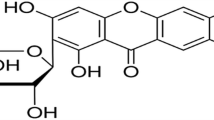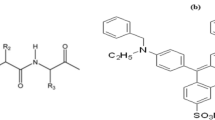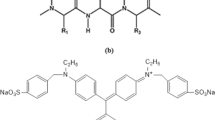Abstract
Historical textiles suffer from deterioration as a result of exposure to uncontrolled environmental conditions in museums. To establish standard conditions for display of undyed and dyed silk fabrics in Egyptian museums, different artificial aging procedures (thermal, light and chemical) were applied to examine their effects on the physical, mechanical and chemical structure of the silk fiber. Samples of undyed silk and silk dyed with madder with different mordants, iron II sulphate; iron III chloride and copper sulphate were used for this purpose. These aged samples were examined for their surface morphology, color parameters (CIE Lab), mechanical properties, degree of crystallinity, secondary structure analysis and amino acids content.









Similar content being viewed by others
References
Garside P, Wyeth P, Zhang X (2010) e Preserv Sci 7:126–131
Szostak-Kotowa J (2004) Inter Biodet Biodeg 53:165–170
Becker M, Magoshi Y, Sakai T, Tuross N (1997) Stud Conserv 42:27–37
Kaplan D, Adams W, Farmer B, Viney C (1994) In: Kaplan D, Adams W, Farmer B, Viney C (eds) Silk polymers materials science and biotechnology. American Chemical Society, Washington, pp 252–269
Gohl E, Vilensky LD (1987) Textile science: an explanation of fibre properties, 2nd edn. Longman Cheshire Pty. Ltd., Melbourne
Guiyang L, Ping Z, Zhengzhong S, Xie X, Xin C, Wang H, Chunyu L, Tongyin Y (2001) Eur J Biochem 268:6600–6606
Needles H, Cassman V, Collins M (1986) Historic textile and paper materials: conservation and characterization. In: Needles HL, Zeronian SH (eds) Advances in chemistry series 212. American Chemical Society, Washington, pp 199–210
Brigitte O (1996) Stud Conserv 41:129–131
David D, Sinclair R, Sterling D (1977) Stud Conserv 22:166–167
Garside P, Wyeth P, Zhang X (2010) J Inst Conserv 33:179–193
Osman E, Michael M, Gohar H (2010) Inter J Chem 2:28–39
Kim J, Wyeth P (2009) e Preserv Sci 6:60–67
Kim J, Zhang X, Wyeth P (2008) e Preserv Sci 5:41–46
Leene J, Demeny L, Elema R, DeGraff A, Surtel J (1958) Proceed Int Council Museums 13:107–242
Massafra M, Seli E, Salsa S, Marcandalli H (1999) J DyPig 40:171–180
Bechtold T, Turcanu A, Ganglberger E, Geissler S (2003) J Clea Prod 11:499–509
Feller L (1994) Accelerated ageing, photochemical and thermal aspects, Marina Del Rey, The Getty Conservation Institute pp 91–114
Chin J, Forster A, Clerici C, Sung L (2007) Pol Deg Stab 92:1234–1246
Tera F (1981) Egyptian patent no. 15182
Segal L, Creely J, Martin J, Conrad C (1959) Text Res J 29:780–794
J. Batcheller (2005), Optical and scanning electron microscopy techniques for the identification of hair fibers from Romano—Egyptian textiles. In: Janaway R, Wyeth P (eds) Scientific analysis of ancient and historic textiles: informing preservation, display and interpretation, AHRC Research Center for Textile Conservation and Textile Studies, First Annual Conference, UK, 13–15, July 2005, pp 51–57
Booth J (1984) Principles of textile testing. Butterworth- Heinemann, USA, pp 118–169
Wyszecki G, Stiles W (2000) Color science concepts and methods, 2nd edn. Quantitative data and formulae, New York
Mary B, Dianne R, Nancie R (1989) The books and paper group annual 9. http://aic.stanford.edu/sg/bpg/annual/v08/bp08-01.html
Michele D (1989) J Ame Inst Cons 28:43–56
Block R, Durrum E, Zweig G (1958) A Manual of paper chromatography and paper electrophorsis, 2nd edn. Academic Press, New York
Timár- Balászy A, Eastop D (1998) Chemical principles of textile conservation. Butterworth-Heinemann, Oxford
Koussoulou T (1999) Papers from the Institute of Archaeology 10:75–88. http://pia-journal.co.uk/index.php/pia/article/viewFile/pia.135/265
Derrick M (1991) Book and paper group annual, The American Institute for Conservation. 10
Kim U, Park J, Li C, Jin H, Valluzzi R, Kaplan D (2004) Biomacromolecules 5:786–792
Lucas E, Shaw J, Smith S (1958) Adv Prot Chem 13:107–242
Yanagi Y, Kondo Y, Hirabayashi K (2000) Tex Res J 70:871–875
Kite M, Thomson R (2006) Conservation of leather and related materials. Butterworth-Heinemann, Oxford
Becker M (1993) The characterization of the initial degradative alterations of Bombyx mori silk fibroin: a comparative study of artificially aged silk fabric and silk fabrics from The First Ladies Collection, Smithsonian Institution, Washington DC’, PhD dissertation, Johns Hopkins University, U.M.I. Dissertation Services, Ann Arbor, Michigan, No. 9327568
Wyeth P, Greiff S, Kutzke H, Riekel C (2005) Surveying silk fiber degradation by crystallinity determination: a study on the tang-dynasty silk treasure from Famen Temple, China. In: Janaway R, Wyeth P (eds) Scientific Analysis of Ancient and Historic Textiles: Informing Preservation, Display and Interpretation AHRC Research Center for Textile Conservation and Textile Studies, First Annual Conference, UK, 13–15 July 2005, pp 38–43
Lee Y (1999) Silk reeling and testing manual, FAO Agricultural Services Bulletin, 136. http://www.fao.org/docrep/x2099E/x2099E00.htm
Author information
Authors and Affiliations
Corresponding author
Rights and permissions
About this article
Cite this article
Ahmed, H.E., Darwish, S.S. Effect of Museum Conditions on Historical Dyed Silk Fabric with Madder Dye. J Polym Environ 20, 596–606 (2012). https://doi.org/10.1007/s10924-012-0421-x
Published:
Issue Date:
DOI: https://doi.org/10.1007/s10924-012-0421-x




